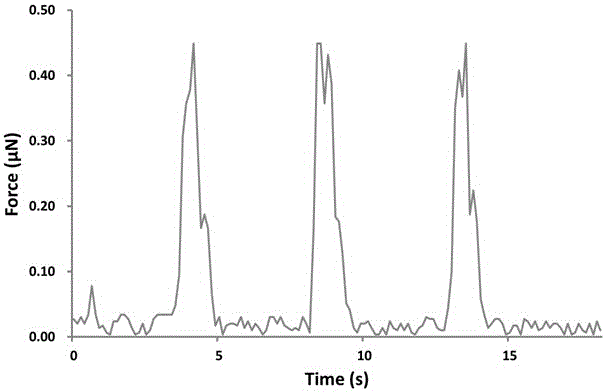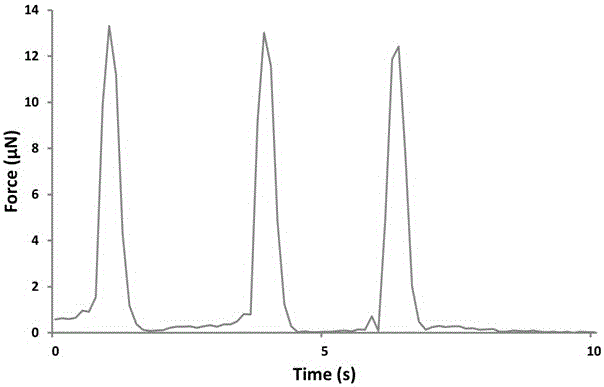Myocardial biomimetic scaffold of composite conductive material and preparation method thereof
A composite conductive and bionic technology, applied in medical science, prosthesis, etc., can solve the problem of inability to proliferate, and achieve the effect of promoting the growth of cardiomyocytes and the formation of myocardial lamellae, increasing the elongation rate, and promoting the growth of cardiomyocytes.
- Summary
- Abstract
- Description
- Claims
- Application Information
AI Technical Summary
Problems solved by technology
Method used
Image
Examples
Embodiment 1
[0026] Step 1. Preparation of graphene oxide-gelatin solution: Weigh 0.6g of gelatin and dissolve it in 10mL of 0.3mg / mL graphene oxide solution. After swelling at room temperature for 30min, dissolve in a water bath at 40°C to form gelatin. Mass volume ratio is 6% graphene oxide-gelatin solution;
[0027] Step 2. Preparation of graphene oxide-gelatin hydrogel scaffold without microstructure: draw 400 μL of the graphene oxide-gelatin solution in step 1 and inject it into a cylindrical mold with an inner diameter of 10 mm, and place it in an environment of 4°C for 2 hours. A microstructure-free graphene oxide-gelatin hydrogel scaffold can be formed.
[0028] Step 3, genipin cross-linked hydrogel: weigh a certain amount of genipin and dissolve it in ultrapure water to form a genipin solution with a mass volume ratio of 0.1%. The graphene oxide-gelatin hydrogel scaffold prepared above was soaked in genipin solution, and placed in a 5°C incubator for cross-linking for 4h. After ...
Embodiment 2
[0030] Step 1. Preparation of graphene oxide-gelatin solution: Weigh 0.6g of gelatin and dissolve it in 10mL of 0.6mg / mL graphene oxide solution. After swelling at room temperature for 30min, dissolve it in a water bath at 60°C to form gelatin. Mass volume ratio is 6% graphene oxide-gelatin solution;
[0031] Step 2. Preparation of graphene oxide-gelatin hydrogel scaffold without microstructure: draw 400 μL of the graphene oxide-gelatin solution in step 1 and inject it into a cylindrical mold with an inner diameter of 10 mm, and place it in an environment of 10°C for 2 hours. A microstructure-free graphene oxide-gelatin hydrogel scaffold can be formed.
[0032] Step 3, genipin cross-linked hydrogel: Weigh a certain amount of genipin and dissolve it in HEPES buffer (10 mM, pH 7.4) to form a genipin solution with a mass volume ratio of 0.2%. The hydrogel scaffold prepared above was soaked in the genipin solution, and placed in an incubator at 25°C for cross-linking for 24 hours...
Embodiment 3
[0034] Step 1. Preparation of graphene oxide-gelatin solution: Weigh 0.6g of gelatin and dissolve it in 10mL of 0.6mg / mL graphene oxide solution. After swelling at room temperature for 30min, dissolve it in a water bath at 60°C to form gelatin. Mass volume ratio is 6% graphene oxide-gelatin solution;
[0035]Step 2. Preparation of graphene oxide-gelatin hydrogel scaffold without microstructure: draw 400 μL of the graphene oxide-gelatin solution in step 1 and inject it into a cylindrical mold with an inner diameter of 10 mm, and place it in an environment of 4°C for 2 hours. A microstructure-free graphene oxide-gelatin hydrogel scaffold can be formed.
[0036] Step 3, genipin cross-linked hydrogel: Weigh a certain amount of genipin and dissolve it in HEPES buffer (10 mM, pH 7.4) to form a genipin solution with a mass volume ratio of 0.8%. The hydrogel scaffold prepared above was soaked in the genipin solution, and placed in an incubator at 25°C for cross-linking for 24 hours. ...
PUM
 Login to View More
Login to View More Abstract
Description
Claims
Application Information
 Login to View More
Login to View More - R&D
- Intellectual Property
- Life Sciences
- Materials
- Tech Scout
- Unparalleled Data Quality
- Higher Quality Content
- 60% Fewer Hallucinations
Browse by: Latest US Patents, China's latest patents, Technical Efficacy Thesaurus, Application Domain, Technology Topic, Popular Technical Reports.
© 2025 PatSnap. All rights reserved.Legal|Privacy policy|Modern Slavery Act Transparency Statement|Sitemap|About US| Contact US: help@patsnap.com



